CustomAdaptor in Syncfusion ASP.NET Core Grid
20 Mar 202524 minutes to read
The CustomAdaptor in the Syncfusion ASP.NET Core Grid allows to create their own custom adaptors by extending the built-in adaptors. The custom adaptor involves handling the built-in adaptor query process, request and response. The CustomAdaptor to be allows extending the OData V4 services, enabling efficient data fetching and manipulation. By default, there are three method for CustomAdaptor built-in methods.
Types of CustomAdaptor methods
There are three types of methods in custom adaptors.
processQuery
The processQuery method handles the execution of a query sent to a dataSource, such as a database or custom data service. This query is responsible for performing operations like data retrieval, insertion, updating, or deletion. The processQuery method accepts two arguments:
-
DataManager: Used to modify the URL dynamically. -
Query: Allows setting additional parameter values or modifying queries such as sorting, filtering, and grouping, etc.
DataManager
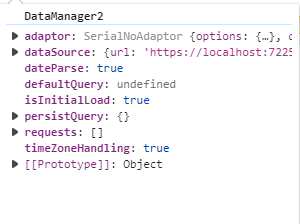
Query
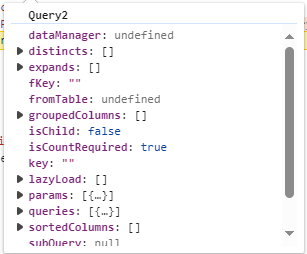
processQuery(dm, query) {
query.addParams('Syncfusion in ASP.NET Core Grid', 'true'); // Add additional parameter.
return super.processQuery.apply(this, arguments);
}beforeSend
The beforeSend method is executed before a request is sent to the server. This function allows modifying parameters, request headers, and data, or performing validation before the request is processed. It accepts three arguments:
-
DataManager: Provides thedataSourceandadaptorvalue. -
Request: Used to send custom headers, such as setting theAuthorizationheader. -
Settings: An optional argument that allows additional configurations.
DataManager

Request
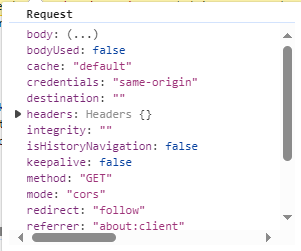
Settings

beforeSend(dm, request, settings) {
if (request){
request.setRequestHeader("Authorization", "true");
}
return super.beforeSend(dm, request, settings);
}processResponse
The processResponse method handles the response received from the server after an asynchronous request. It is responsible for parsing the response data, managing errors, and preparing the data for further processing. This method can accept multiple optional arguments, allowing customization based on specific requirements.
processResponse(data, ds, query, xhr, request, changes) {
let i =0;
const original = super.processResponse(data, ds, query, xhr, request, changes);
// Adding serial number.
if (original.result){
original.result.forEach((item) => ej.base.setValue('SNo', ++i, item));
}
return original;
}This guide provides detailed instructions on binding data and performing CRUD (Create, Read, Update, Delete) actions using the CustomAdaptor by extending the ODataV4Adaptor in your Syncfusion ASP.NET Core Grid.
Creating an custom service
To configure a server with Syncfusion ASP.NET Core Grid, you need to follow the below steps:
1. Project Creation:
Open Visual Studio and create an ASP.NET Core project named CustomAdaptor. To create an ASP.NET Core application, follow the documentation link for detailed steps.
2. Install NuGet Packages
Using the NuGet package manager in Visual Studio (Tools → NuGet Package Manager → Manage NuGet Packages for Solution), install the Microsoft.AspNetCore.OData NuGet package.
3. Model Class Creation:
Create a model class named OrdersDetails.cs inside the Models folder.
namespace CustomAdaptor.Models
{
public class OrdersDetails
{
public static List<OrdersDetails> order = new List<OrdersDetails>();
public OrdersDetails()
{
}
public OrdersDetails(int OrderID, string CustomerId, int EmployeeId, double Freight, bool Verified, DateTime OrderDate, string ShipCity, string ShipName, string ShipCountry, DateTime ShippedDate, string ShipAddress)
{
this.OrderID = OrderID;
this.CustomerID = CustomerId;
this.EmployeeID = EmployeeId;
this.Freight = Freight;
this.ShipCity = ShipCity;
this.Verified = Verified;
this.OrderDate = OrderDate;
this.ShipName = ShipName;
this.ShipCountry = ShipCountry;
this.ShippedDate = ShippedDate;
this.ShipAddress = ShipAddress;
}
public static List<OrdersDetails> GetAllRecords()
{
if (order.Count() == 0)
{
int code = 10000;
for (int i = 1; i < 10; i++)
{
order.Add(new OrdersDetails(code + 1, "ALFKI", i + 0, 2.3 * i, false, new DateTime(1991, 05, 15), "Berlin", "Simons bistro", "Denmark", new DateTime(1996, 7, 16), "Kirchgasse 6"));
order.Add(new OrdersDetails(code + 2, "ANATR", i + 2, 3.3 * i, true, new DateTime(1990, 04, 04), "Madrid", "Queen Cozinha", "Brazil", new DateTime(1996, 9, 11), "Avda. Azteca 123"));
order.Add(new OrdersDetails(code + 3, "ANTON", i + 1, 4.3 * i, true, new DateTime(1957, 11, 30), "Cholchester", "Frankenversand", "Germany", new DateTime(1996, 10, 7), "Carrera 52 con Ave. Bolívar #65-98 Llano Largo"));
order.Add(new OrdersDetails(code + 4, "BLONP", i + 3, 5.3 * i, false, new DateTime(1930, 10, 22), "Marseille", "Ernst Handel", "Austria", new DateTime(1996, 12, 30), "Magazinweg 7"));
order.Add(new OrdersDetails(code + 5, "BOLID", i + 4, 6.3 * i, true, new DateTime(1953, 02, 18), "Tsawassen", "Hanari Carnes", "Switzerland", new DateTime(1997, 12, 3), "1029 - 12th Ave. S."));
code += 5;
}
}
return order;
}
[Key]
public int OrderID { get; set; }
public string CustomerID { get; set; }
public int? EmployeeID { get; set; }
public double Freight { get; set; }
public string ShipCity { get; set; }
public bool Verified { get; set; }
public DateTime OrderDate { get; set; }
public string ShipName { get; set; }
public string ShipCountry { get; set; }
public DateTime ShippedDate { get; set; }
public string ShipAddress { get; set; }
}
}4. Build the Entity Data Model
To construct the Entity Data Model for your OData service, utilize the ODataConventionModelBuilder to define the model’s structure. Start by creating an instance of the ODataConventionModelBuilder, then register the entity set Orders using the EntitySet<T> method, where OrdersDetails represents the CLR type containing order details.
using CustomAdaptor.Models;
using Microsoft.AspNetCore.OData;
using Microsoft.OData.ModelBuilder;
// Create an ODataConventionModelBuilder to build the OData model.
var modelBuilder = new ODataConventionModelBuilder();
// Register the "Orders" entity set with the OData model builder.
modelBuilder.EntitySet<OrdersDetails>("Orders");5. Register the OData Services
Once the Entity Data Model is built, you need to register the OData services in your ASP.NET Core application. Here’s how:
// Add controllers with OData support to the service collection.
builder.Services.AddControllers().AddOData(
options => options
.Count()
.AddRouteComponents("odata", modelBuilder.GetEdmModel()));6. Add Controllers
Finally, add controllers to expose the OData endpoints. Here’s an example:
using Microsoft.AspNetCore.Mvc;
using Microsoft.AspNetCore.OData.Query;
using CustomAdaptor.Models;
namespace CustomAdaptor.Controllers
{
[Route("[controller]")]
[ApiController]
public class OrdersController : ControllerBase
{
/// <summary>
/// Retrieves all orders.
/// </summary>
/// <returns>The collection of orders.</returns>
[HttpGet]
[EnableQuery]
public IActionResult Get()
{
var data = OrdersDetails.GetAllRecords().AsQueryable();
return Ok(data);
}
}
}7. Run the Application:
Run the application in Visual Studio. It will be accessible on a URL like https://localhost:xxxx.
After running the application, you can verify that the server-side API controller is successfully returning the order data in the URL(https://localhost:xxxx/odata/Orders). Here xxxx denotes the port number.
Connecting Syncfusion ASP.NET Core Grid to an custom service extending the ODataV4 service
To integrate the Syncfusion Grid into your ASP.NET Core project using Visual Studio, follow these steps:
Step 1: Install the Syncfusion ASP.NET Core Package:
To add ASP.NET Core in the application, open the NuGet package manager in Visual Studio (Tools → NuGet Package Manager → Manage NuGet Packages for Solution), search for Syncfusion.EJ2.AspNet.Core and install it.
Alternatively, you can install it using the following Package Manager Console command:
Install-Package Syncfusion.EJ2.AspNet.Core -Version 32.1.19Step 2: Add Syncfusion ASP.NET Core Tag Helper
Open ~/Pages/_ViewImports.cshtml file and import the Syncfusion.EJ2 TagHelper.
@addTagHelper *, Syncfusion.EJ2Step 3: Add Stylesheets and Script Resources
To include the required styles and scripts, add the following references inside the <head> of ~/Pages/Shared/_Layout.cshtml file:
<head>
...
<!-- Syncfusion ASP.NET Core control styles -->
<link rel="stylesheet" href="https://cdn.syncfusion.com/ej2/32.1.19/bootstrap5.css" />
<!-- Syncfusion ASP.NET Core control scripts -->
<script src="https://cdn.syncfusion.com/ej2/32.1.19/dist/ej2.min.js"></script>
<!-- Include the necessary CSS files to style the Syncfusion ASP.NET Core controls-->
<link href="https://cdn.syncfusion.com/ej2/32.1.19/ej2-base/styles/bootstrap5.css" rel="stylesheet" />
<link href="https://cdn.syncfusion.com/ej2/32.1.19/ej2-grids/styles/bootstrap5.css" rel="stylesheet" />
<link href="https://cdn.syncfusion.com/ej2/32.1.19/ej2-buttons/styles/bootstrap5.css" rel="stylesheet" />
<link href="https://cdn.syncfusion.com/ej2/32.1.19/ej2-popups/styles/bootstrap5.css" rel="stylesheet" />
<link href="https://cdn.syncfusion.com/ej2/32.1.19/ej2-richtexteditor/styles/bootstrap5.css" rel="stylesheet" />
<link href="https://cdn.syncfusion.com/ej2/32.1.19/ej2-navigations/styles/bootstrap5.css" rel="stylesheet" />
<link href="https://cdn.syncfusion.com/ej2/32.1.19/ej2-dropdowns/styles/bootstrap5.css" rel="stylesheet" />
<link href="https://cdn.syncfusion.com/ej2/32.1.19/ej2-lists/styles/bootstrap5.css" rel="stylesheet" />
<link href="https://cdn.syncfusion.com/ej2/32.1.19/ej2-inputs/styles/bootstrap5.css" rel="stylesheet" />
<link href="https://cdn.syncfusion.com/ej2/32.1.19/ej2-calendars/styles/bootstrap5.css" rel="stylesheet" />
<link href="https://cdn.syncfusion.com/ej2/32.1.19/ej2-notifications/styles/bootstrap5.css" rel="stylesheet" />
<link href="https://cdn.syncfusion.com/ej2/32.1.19/ej2-splitbuttons/styles/bootstrap5.css" rel="stylesheet" />
<script src="https://cdnjs.cloudflare.com/ajax/libs/systemjs/0.19.38/system.js"></script>
<script src="https://cdn.syncfusion.com/ej2/syncfusion-helper.js" type="text/javascript"></script>
</head>Step 4: Register Syncfusion Script Manager:
To ensure proper script execution, register the Syncfusion Script Manager <ejs-scripts> at the end of the <body> tag in your ASP.NET Core application as follows:
<body>
...
<!-- Syncfusion ASP.NET Core Script Manager -->
<ejs-scripts></ejs-scripts>
</body>Step 5: Adding Custom Adaptor
To create a custom adaptor, extend the ODataV4Adaptor. This custom adaptor will implement three key methods: processQuery, beforeSend, and processResponse.
-
The
processQuerymethod modifies the API endpoint URL and sets additional parameters required for executing the query. -
The
beforeSendmethod adds custom headers, such as theAuthorizationheader, before sending the request. -
The
processResponsemethod customizes the response by modifying data, such as adding a new field (SNo) to the dataset.
<script>
class CustomAdaptor extends ej.data.ODataV4Adaptor {
processResponse(data, ds, query, xhr, request, changes) {
let i = 0;
const original = super.processResponse(data, ds, query, xhr, request, changes);
// Adding serial number to each row.
if (original.result) {
original.result.forEach((item) => ej.base.setValue('SNo', ++i, item));
}
return original;
}
beforeSend(dm, request, settings) {
if (request){
request.setRequestHeader("Authorization", "true");
}
return super.beforeSend(dm, request, settings);
}
processQuery(dm, query) {
dm.dataSource.url = 'https://localhost:xxxx/odata/orders'; // Update with your API endpoint.
query.addParams('Syncfusion in ASP.NET Core Grid', 'true'); // Add additional parameters.
return super.processQuery.apply(this, arguments);
}
}
document.addEventListener("DOMContentLoaded", function () {
let grid = document.getElementById("Grid").ej2_instances[0];
if (grid) {
let dataManager = new ej.data.DataManager({
url: "https://localhost:xxxx/odata/Orders", // Replace `xxxx` with your actual localhost port number.
adaptor: new CustomAdaptor(),
});
grid.dataSource = dataManager;
}
});
</script>Step 6: Adding Syncfusion Grid
Define a DataManager instance, specifying the API endpoint (https://localhost:xxxx/odata/Orders) in the url property and setting the adaptor to CustomAdaptor.
@page
@model IndexModel
@{
ViewData["Title"] = "Home page";
}
<div>
<ejs-grid id="Grid" height="315">
<e-grid-columns>
<e-grid-column field="SNo" headerText="S.No" width="120" textAlign="Right"></e-grid-column>
<e-grid-column field="OrderID" headerText="Order ID" width="120" textAlign="Right" isPrimaryKey="true"></e-grid-column>
<e-grid-column field="CustomerID" headerText="Customer ID" width="150"></e-grid-column>
<e-grid-column field="EmployeeID" headerText="Employee ID" width="150"></e-grid-column>
<e-grid-column field="ShipCountry" headerText="Ship Country" width="150"></e-grid-column>
</e-grid-columns>
</ejs-grid>
</div>
<script>
class CustomAdaptor extends ej.data.ODataV4Adaptor {}
document.addEventListener("DOMContentLoaded", function () {
let grid = document.getElementById("Grid").ej2_instances[0];
if (grid) {
let dataManager = new ej.data.DataManager({
url: "https://localhost:xxxx/odata/Orders", // Replace `xxxx` with your actual localhost port number.
adaptor: new CustomAdaptor()
});
grid.dataSource = dataManager;
}
});
</script>Step 7: Configure the server:
In the Program.cs file of your project, configure the server to serve static files and handle API requests by adding the following code:
builder.Services.AddRazorPages();
builder.Services.AddControllers();
var app = builder.Build();
app.MapRazorPages();
app.MapControllers();Step 8: Run the Project:
Run the project in Visual Studio, and the Syncfusion ASP.NET Core Grid will successfully fetch data from the API service.
Replace https://localhost:xxxx/odata/Orders with the actual URL of your API endpoint that provides the data in a consumable format (e.g., JSON).
Handling searching operation
To enable search operations in your web application using OData, you first need to configure the OData support in your service collection. This involves adding the Filter method within the OData setup, allowing you to filter data based on specified criteria. Once enabled, clients can utilize the $filter query option in their requests to search for specific data entries.
<ejs-grid id="Grid" height="280" toolbar="@(new List<string>() { "Search"})">
<e-grid-columns>
<e-grid-column field="OrderID" headerText="Order ID" width="120" textAlign="Right" isPrimaryKey="true" type="number"></e-grid-column>
<e-grid-column field="CustomerID" headerText="Customer ID" width="150" type="string"></e-grid-column>
<e-grid-column field="EmployeeID" headerText="Employee ID" width="150"></e-grid-column>
<e-grid-column field="ShipCountry" headerText="Ship Country" width="150"></e-grid-column>
</e-grid-columns>
</ejs-grid>
<script>
class CustomAdaptor extends ej.data.ODataV4Adaptor {}
document.addEventListener("DOMContentLoaded", function () {
let grid = document.getElementById("Grid").ej2_instances[0];
if (grid) {
let dataManager = new ej.data.DataManager({
url: "https://localhost:xxxx/odata/Orders", // Replace `xxxx` with your actual localhost port number.
adaptor: new CustomAdaptor()
});
grid.dataSource = dataManager;
}
});
</script>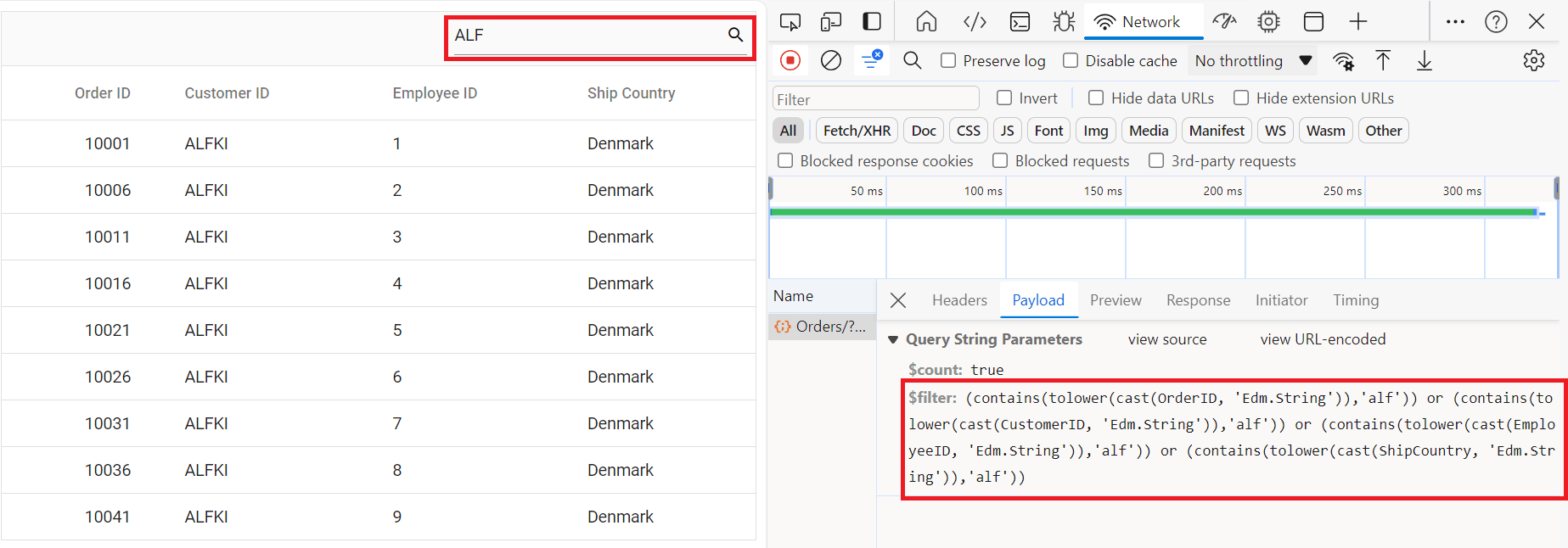
Handling filtering operation
To enable filter operations in your web application using OData, you first need to configure the OData support in your service collection. This involves adding the Filter method within the OData setup, allowing you to filter data based on specified criteria. Once enabled, clients can utilize the $filter query option in your requests to filter for specific data entries.
// Create a new instance of the web application builder.
var builder = WebApplication.CreateBuilder(args);
// Create an ODataConventionModelBuilder to build the OData model.
var modelBuilder = new ODataConventionModelBuilder();
// Register the "Orders" entity set with the OData model builder.
modelBuilder.EntitySet<OrdersDetails>("Orders");
// Add services to the container.
// Add controllers with OData support to the service collection.
builder.Services.AddControllers().AddOData(
options => options
.Count()
.Filter()
.AddRouteComponents("odata", modelBuilder.GetEdmModel()));<ejs-grid id="Grid" height="280" allowFiltering="true">
<e-grid-columns>
<e-grid-column field="OrderID" headerText="Order ID" width="120" textAlign="Right" isPrimaryKey="true" type="number"></e-grid-column>
<e-grid-column field="CustomerID" headerText="Customer ID" width="150" type="string"></e-grid-column>
<e-grid-column field="EmployeeID" headerText="Employee ID" width="150"></e-grid-column>
<e-grid-column field="ShipCountry" headerText="Ship Country" width="150"></e-grid-column>
</e-grid-columns>
</ejs-grid>
<script>
class CustomAdaptor extends ej.data.ODataV4Adaptor {}
document.addEventListener("DOMContentLoaded", function () {
let grid = document.getElementById("Grid").ej2_instances[0];
if (grid) {
let dataManager = new ej.data.DataManager({
url: "https://localhost:xxxx/odata/Orders", // Replace `xxxx` with your actual localhost port number.
adaptor: new CustomAdaptor()
});
grid.dataSource = dataManager;
}
});
</script>Single column filtering

Multi column filtering

Handling sorting operation
To enable sorting operations in your web application using OData, you first need to configure the OData support in your service collection. This involves adding the OrderBy method within the OData setup, allowing you to sort data based on specified criteria. Once enabled, clients can utilize the $orderby query option in their requests to sort data entries according to desired attributes.
// Create a new instance of the web application builder.
var builder = WebApplication.CreateBuilder(args);
// Create an ODataConventionModelBuilder to build the OData model.
var modelBuilder = new ODataConventionModelBuilder();
// Register the "Orders" entity set with the OData model builder.
modelBuilder.EntitySet<OrdersDetails>("Orders");
// Add services to the container.
// Add controllers with OData support to the service collection.
builder.Services.AddControllers().AddOData(
options => options
.Count()
.OrderBy()
.AddRouteComponents("odata", modelBuilder.GetEdmModel()));<ejs-grid id="Grid" height="280" allowSorting="true">
<e-grid-columns>
<e-grid-column field="OrderID" headerText="Order ID" width="120" textAlign="Right" isPrimaryKey="true" type="number"></e-grid-column>
<e-grid-column field="CustomerID" headerText="Customer ID" width="150" type="string"></e-grid-column>
<e-grid-column field="EmployeeID" headerText="Employee ID" width="150"></e-grid-column>
<e-grid-column field="ShipCountry" headerText="Ship Country" width="150"></e-grid-column>
</e-grid-columns>
</ejs-grid>
<script>
class CustomAdaptor extends ej.data.ODataV4Adaptor {}
document.addEventListener("DOMContentLoaded", function () {
let grid = document.getElementById("Grid").ej2_instances[0];
if (grid) {
let dataManager = new ej.data.DataManager({
url: "https://localhost:xxxx/odata/Orders", // Replace `xxxx` with your actual localhost port number.
adaptor: new CustomAdaptor()
});
grid.dataSource = dataManager;
}
});
</script>Single column sorting

Multi column sorting

Handling paging operation
To implement paging operations in your web application using OData, you can utilize the SetMaxTop method within your OData setup to limit the maximum number of records that can be returned per request. While you configure the maximum limit, clients can utilize the $skip and $top query options in their requests to specify the number of records to skip and the number of records to take, respectively.
// Create a new instance of the web application builder.
var builder = WebApplication.CreateBuilder(args);
// Create an ODataConventionModelBuilder to build the OData model.
var modelBuilder = new ODataConventionModelBuilder();
// Register the "Orders" entity set with the OData model builder.
modelBuilder.EntitySet<OrdersDetails>("Orders");
// Add services to the container.
// Add controllers with OData support to the service collection.
var recordCount= OrdersDetails.GetAllRecords().Count;
builder.Services.AddControllers().AddOData(
options => options
.Count()
.SetMaxTop(recordCount)
.AddRouteComponents(
"odata",
modelBuilder.GetEdmModel()));<ejs-grid id="Grid" height="280" allowPaging="true">
<e-grid-columns>
<e-grid-column field="OrderID" headerText="Order ID" width="120" textAlign="Right" isPrimaryKey="true" type="number"></e-grid-column>
<e-grid-column field="CustomerID" headerText="Customer ID" width="150" type="string"></e-grid-column>
<e-grid-column field="EmployeeID" headerText="Employee ID" width="150"></e-grid-column>
<e-grid-column field="ShipCountry" headerText="Ship Country" width="150"></e-grid-column>
</e-grid-columns>
</ejs-grid>
<script>
class CustomAdaptor extends ej.data.ODataV4Adaptor {}
document.addEventListener("DOMContentLoaded", function () {
let grid = document.getElementById("Grid").ej2_instances[0];
if (grid) {
let dataManager = new ej.data.DataManager({
url: "https://localhost:xxxx/odata/Orders", // Replace `xxxx` with your actual localhost port number.
adaptor: new CustomAdaptor()
});
grid.dataSource = dataManager;
}
});
</script>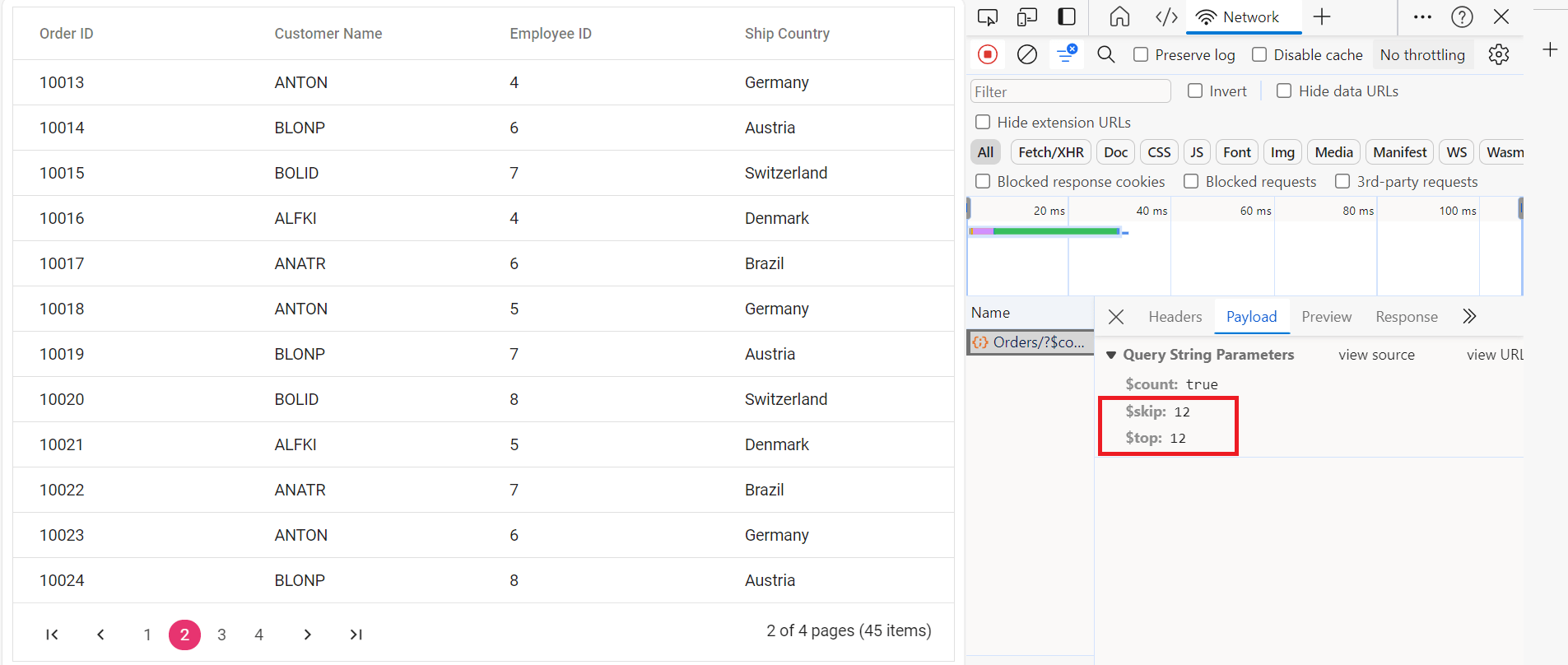
Handling CRUD operations
To manage CRUD (Create, Read, Update, Delete) operations using the ODataV4Adaptor, follow the provided guide for configuring the Syncfusion Grid for editing and utilize the sample implementation of the OrdersController in your server application. This controller handles HTTP requests for CRUD operations such as GET, POST, PATCH, and DELETE.
To enable CRUD operations in the Syncfusion ASP.NET Core Grid, follow the below steps:
<ejs-grid id="Grid" height="280" toolbar="@(new List<string>() { "Add", "Edit", "Delete", "Update", "Cancel", "Search"})">
<e-grid-editSettings allowAdding="true" allowDeleting="true" allowEditing="true" mode="Normal"></e-grid-editSettings>
<e-grid-columns>
<e-grid-column field="OrderID" headerText="Order ID" width="120" textAlign="Right" isPrimaryKey="true" type="number"></e-grid-column>
<e-grid-column field="CustomerID" headerText="Customer ID" width="150" type="string"></e-grid-column>
<e-grid-column field="EmployeeID" headerText="Employee ID" width="150"></e-grid-column>
<e-grid-column field="ShipCountry" headerText="Ship Country" width="150"></e-grid-column>
</e-grid-columns>
</ejs-grid>
<script>
class CustomAdaptor extends ej.data.ODataV4Adaptor {}
document.addEventListener("DOMContentLoaded", function () {
let grid = document.getElementById("Grid").ej2_instances[0];
if (grid) {
let dataManager = new ej.data.DataManager({
url: "https://localhost:xxxx/odata/Orders", // Replace `xxxx` with your actual localhost port number.
adaptor: new CustomAdaptor()
});
grid.dataSource = dataManager;
}
});
</script>Normal/Inline editing is the default edit
Modefor the Grid. To enable CRUD operations, ensure that the isPrimaryKey property is set to true for a specific Grid column, ensuring that its value is unique.
Insert Record
To insert a new record into your Syncfusion Grid, you can utilize the HttpPost method in your server application. Below is a sample implementation of inserting a record using the OrdersController:
/// <summary>
/// Inserts a new order to the collection.
/// </summary>
/// <param name="addRecord">The order to be inserted.</param>
/// <returns>It returns the newly inserted record detail.</returns>
[HttpPost]
[EnableQuery]
public IActionResult Post([FromBody] OrdersDetails addRecord)
{
if (addRecord == null)
{
return BadRequest("Null order");
}
OrdersDetails.GetAllRecords().Insert(0, addRecord);
return Ok(addRecord);
}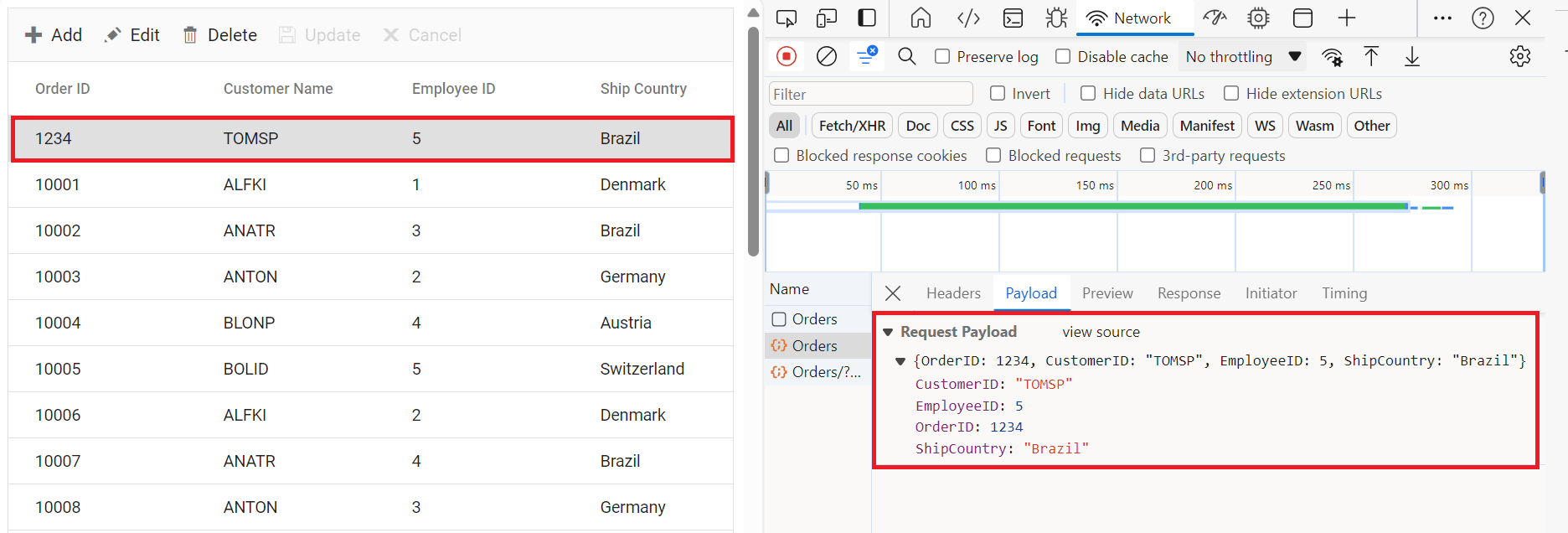
Update Record
Updating a record in the Syncfusion Grid can be achieved by utilizing the HttpPatch method in your controller. Here’s a sample implementation of updating a record:
/// <summary>
/// Updates an existing order.
/// </summary>
/// <param name="key">The ID of the order to update.</param>
/// <param name="updateRecord">The updated order details.</param>
/// <returns>It returns the updated order details.</returns>
[HttpPatch("{key}")]
public IActionResult Patch(int key, [FromBody] OrdersDetails updateRecord)
{
if (updateRecord == null)
{
return BadRequest("No records to update.");
}
var existingOrder = OrdersDetails.GetAllRecords().FirstOrDefault(order => order.OrderID == key);
if (existingOrder == null)
{
return NotFound($"Order with ID {key} not found.");
}
// Update fields only if they are provided.
existingOrder.CustomerID = updateRecord.CustomerID ?? existingOrder.CustomerID;
existingOrder.EmployeeID = updateRecord.EmployeeID ?? existingOrder.EmployeeID;
existingOrder.ShipCountry = updateRecord.ShipCountry ?? existingOrder.ShipCountry;
// Return the updated record.
return Ok(existingOrder);
}
Delete Record
To delete a record from your Syncfusion Grid, you can utilize the HttpDelete method in your controller. Below is a sample implementation:
/// <summary>
/// Deletes an order.
/// </summary>
/// <param name="key">The ID of the order to delete.</param>
/// <returns>It returns the deleted record detail.</returns>
[HttpDelete("{key}")]
public IActionResult Delete(int key)
{
var deleteRecord = OrdersDetails.GetAllRecords().FirstOrDefault(order => order.OrderID == key);
if (deleteRecord != null)
{
OrdersDetails.GetAllRecords().Remove(deleteRecord);
}
return Ok(deleteRecord);
}